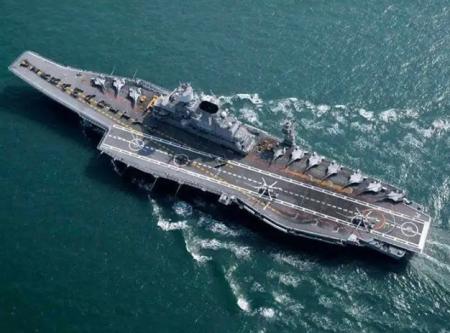Everything about the Indian Navy's Aircraft Carrier, INS vikramaditya
How's the Josh Warriors?
Hello Buddies, I hope you are applying every inch of hard work and effort to earn the prestigious uniform of the Indian Armed Forces. In this appreciable blog, I am going to profile one of the elite Aircraft Carriers i.e. INS Vikramaditya
Interesting Highlights of an Aircraft Carrier:
TYPE
Aircraft carrier
OPERATOR
Indian Navy
DISPLACEMENT
44,500 t
ENDURANCE
45 days
SPEED
30 kt
RANGE
7,000 nmi
- INS Vikramaditya is the Indian Navy’s largest Short Take-Off But Assisted Recovery (STOBAR) aircraft carrier, warship converted from the Russian Navy’s Decommissioned Admiral Gorshkov (Vertical Take Off and Landing – VTOL) missile cruiser carrier.
- INS Vikramaditya was commissioned into service in November 2013 for the Indian Navy.
- The warship has been extensively refurbished with new propulsion systems, hull sections, sensors and flight deck.
- INS Vikramaditya was operationally deployed with full complement of MiG-29 aircraft in May 2014.
- The vessel can carry more than 30 long-range multi-role fighters with anti-ship missiles, air-to-air missiles, guided bombs and rockets.
- The aircraft aboard the carrier include MiG 29K / Sea Harrier Combat Aircraft, Kamov 31 radar picket Airborne Early Warning (AEW) helicopter, Kamov 28 naval helicopter, Sea King helicopter, ALH-Dhruv, and Chetak helicopter.
Order and Delivery of an Aircraft Carrier:
- India entered into negotiations with Russia for the acquisition of Admiral Gorshkov Aircraft Carrier in 1994 and signed a memorandum of understanding in December 1998.
- The Union Government of India and the Federation of Russia signed an inter-governmental agreement for the acquisition in October 2000.
- In January 2004, India signed a $1.5 billion deal with Russia for the modernisation of Admiral Gorshkov and delivery of 12 single-seat MiG-29K and four two-seat MiG-29KUB aircraft.
- The refurbishment works were commenced at the FSUE Sevmash Shipyard in Severodvinsk (Russia) in April 2004.
- The cost for repair and refit of the carrier, spares, infrastructure augmentation and documentation was estimated to be $974 million.
- The modernised warship was initially scheduled to be delivered by August 2008 but was delayed due to cost overruns.
- The two countries reached an agreement on the final delivery and entire cost of the upgraded warship in December 2009. The deal was finalised in March 2010, the cost was fixed at $2.33 billion and delivery was scheduled for December 2012.
- The overhaul was completed by March 2012 and the first sea trials began in June 2012. The delivery was however delayed again due to defects encountered in boilers and the need for replacement of additional electrical cables.
- The modernised carrier completed final sea trials in the White Sea in July 2013 and aviation trials in November 2013.
Design and Modernisation of an Aircraft Carrier:
- The refurbished aircraft carrier INS Vikramaditya is equipped with 234 new hull sections constructed using 2,500 t of steel.
- It has an overall length of 284 m, a maximum beam of 60 m, height of about 60 m and a displacement of 44,500 t.
- The warship features 22 decks and 2,500 compartments, of which 1,750 were completely re-built.
- INS Vikramaditya can carry more than 1,600 personnel including crew.
- Sponsons are installed in INS Vikramaditya to increase the breadth at the flight deck.
- The modernised ship is also equipped with flight deck lighting systems, new AC plants, refrigeration plants, 14° sky jump, 30 m wide arrester gears, three restraining gears, and two reverse osmosis plants for producing 400 t of fresh water per day.
- The modifications also included replacement of 2,300 km of old electrical cables with new cables, upgrades to bulbous bow, and replacement of distilling plants.
Sensors Installed in an Aircraft Carrier:
- The re-equipped superstructure of the INS Vikramaditya houses state-of-the-art launch and recovery systems, long-range air surveillance radars and advanced electronic warfare suite.
- The latest CCS MK II communication complex provides external communication to the INS Vikramaditya.
- The aircraft carrier is equipped with LUNA and DAPS landing systems for MiG and Sea Harriers jet fighters respectively.
- A Computer Aided Action Information Organisation (CAIO) system named LESORUB-E is fitted to provide combat control and direction.
- The system collects information from sensors and data links and performs computer-aided processing.
- The ship is also fitted with an automated Resistor-E radar complex and various subsystems to provide air traffic control and approach / landing for carrier-based aircraft.
- The radar system provides short-range navigation and flight data for the aircraft.
- The precision approach guidance system of the Resistor-E complex provides flying craft guidance during a precision approach.
- A Link II tactical data system is also installed to support network centric operations.
Propulsion and Performance of an Aircraft Carrier:
- INS Vikramaditya is powered by eight new generation boilers which produce a total power of 180,000 shp driving four huge propellers.
- Each boiler of INS Vikramaditya generates 100 tph of steam at a very high pressure of 64 bar.
- The ship also employs six turbo alternators and six diesel alternators, which produce a total power of 18 MW.
- The warship can carry more than 8,000 t of low sulphur high speed diesel.
- INS Vikray has a maximum speed of over 30 kt and can attain a maximum range of 7,000 nmi, with an endurance of 45 days.
I hope the article was helpful for all the defence aspirants, if you have any doubt at all or you want to suggest me anything then please leave a comment to help you in least possible time!!
Keep Your Motivation High & Stay Updated to the Defence Direct Education
⚔ Jai Hind ⚔






 Order Now on Amazon
Order Now on Amazon
